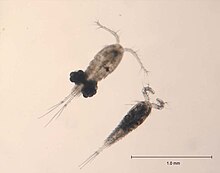en
names in breadcrumbs


Cyclops is one of the most common genera of freshwater copepods, comprising over 400 species.[1][2] Together with other similar-sized non-copepod fresh-water crustaceans, especially cladocera, they are commonly called water fleas. The name Cyclops comes from the Cyclops of Greek mythology, as they have a single large eye; in Cyclops, the eye may be either red or black.

Cyclops individuals may range from ½–5 mm long[3] and are clearly divided into two sections. The broadly oval front section comprises the head and the first five thoracic segments. The hind part is considerably slimmer and is made up of the sixth thoracic segment and the four legless pleonic segments. Two caudal appendages project from the rear. Although they may be difficult to observe, Cyclops has 5 pairs of legs. The long first antennae, 2 in number, are used by the males for gripping the females during mating. Afterwards, the female carries the eggs in two small sacs on her body. The larvae, or nauplii, are free-swimming and unsegmented.
Cyclops has a cosmopolitan distribution in fresh water, but is less frequent in brackish water. It lives along the plant-covered banks of stagnant and slow-flowing bodies of water, where it feeds on small fragments of plant material, animals (such as nematodes), or carrion. It swims with characteristic jerky movements. Cyclops has the capacity to survive unsuitable conditions by forming a cloak of slime. Average lifespan is about 3 months.
Cyclops is intermediate host of dracunculiasis (guinea-worm disease) and fish tapeworm (Diphyllobothrium latum) infection. This disease can be passed to humans through drinking infected water. Dracunculiasis will rarely cause death but is a weakening disease.[4]
Cyclops can be controlled using physical, chemical, biological and engineering methods.
Straining of water through piece of fine cloth is sufficient to remove Cyclops. It can also be killed by boiling water, as it is easily killed by heat at 60 °C.
Chlorine in strength of 22 ppm destroys Cyclops in 2 hours;[5] although this concentration of chlorine gives bad odour and taste to water. Excess chlorine can be removed with Sodium thiosulfate. Calcium hydroxide at dosage of 4 gram per gallon of water can be used. Temefos kills cyclops at concentration of 1 mg/litre.
Small fish like barbel and Gambusia feed on Cyclops. This type of predation was used in Indian state of Karnataka to eradicate dracunculiasis.[6]
Provision of drinking water through piping water supply, use of tubewells and abolition of stepwells are effective measures on community level.[7]
 Female and male Cyclops bicuspidatus, the dominant cyclopoid species in Lake Michigan
Female and male Cyclops bicuspidatus, the dominant cyclopoid species in Lake Michigan Cyclops is one of the most common genera of freshwater copepods, comprising over 400 species. Together with other similar-sized non-copepod fresh-water crustaceans, especially cladocera, they are commonly called water fleas. The name Cyclops comes from the Cyclops of Greek mythology, as they have a single large eye; in Cyclops, the eye may be either red or black.
 Nauplius larva of Cyclops
Nauplius larva of Cyclops